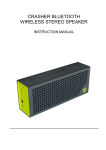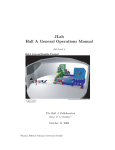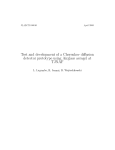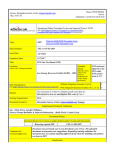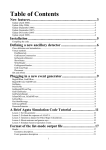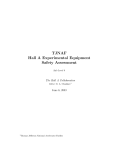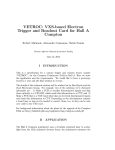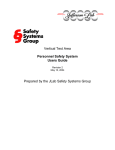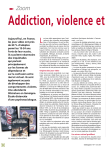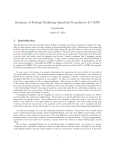Download OSP Hall A - Jefferson Lab
Transcript
Experiment Safety Assessment Document (ESAD) for Experimental Hall A Base Equipment February 2, 2015 Contents 1 Introduction 3 2 General Hazards 2.1 Radiation . . . . . . . . . . . . . . . . . . . . . 2.2 Fire . . . . . . . . . . . . . . . . . . . . . . . . 2.3 Electrical Systems . . . . . . . . . . . . . . . . . 2.4 Mechanical Systems . . . . . . . . . . . . . . . . 2.5 Strong Magnetic Fields . . . . . . . . . . . . . . 2.6 Cryogenic Fluids and Oxygen Deficiency Hazard 2.7 Vacuum and Pressure Vessels . . . . . . . . . . 2.8 Hazardous Materials . . . . . . . . . . . . . . . 2.9 Lasers . . . . . . . . . . . . . . . . . . . . . . . . . . . . . . . . 4 4 4 5 5 5 5 6 6 6 . . . . . . . . . . . . . . . . . . . 8 8 8 8 9 9 10 10 10 10 11 12 12 12 15 17 17 17 17 18 . . . . . . . . . . . . . . . . . . 3 Hall Specific Equipment 3.1 Overview . . . . . . . . . . . . . . . . . . . . . . . . 3.2 Checking Tie-in To Machine Fast Shutdown System 3.3 Beamline . . . . . . . . . . . . . . . . . . . . . . . . 3.3.1 Hazards . . . . . . . . . . . . . . . . . . . . 3.3.2 Mitigations . . . . . . . . . . . . . . . . . . 3.3.3 Responsible Personnel . . . . . . . . . . . . 3.4 Arc Energy Measurement . . . . . . . . . . . . . . 3.4.1 Hazards . . . . . . . . . . . . . . . . . . . . 3.4.2 Mitigations . . . . . . . . . . . . . . . . . . 3.4.3 Responsible Personnel . . . . . . . . . . . . 3.5 Cryogenic Target System . . . . . . . . . . . . . . . 3.5.1 Hazards . . . . . . . . . . . . . . . . . . . . 3.5.2 Mitigations . . . . . . . . . . . . . . . . . . 3.5.3 Responsible Personnel . . . . . . . . . . . . 3.6 Vacuum Systems . . . . . . . . . . . . . . . . . . . 3.6.1 Hazards . . . . . . . . . . . . . . . . . . . . 3.6.2 Mitigations . . . . . . . . . . . . . . . . . . 3.6.3 Responsible Personnel . . . . . . . . . . . . 3.7 High Resolution Spectrometers . . . . . . . . . . . 1 . . . . . . . . . . . . . . . . . . . . . . . . . . . . . . . . . . . . . . . . . . . . . . . . . . . . . . . . . . . . . . . . . . . . . . . . . . . . . . . . . . . . . . . . . . . . . . . . . . . . . . . . . . . . . . . . . . . . . . . . . . . . . . . . . . . . . . . . . . . . . . . . . . . . . . . . . . . . . . . . . . . . . . . . . . . . . . . . . . . . . . . . . . . . . . . . . . . . . . . . . . . . . . . . . . . . . . . . . . . . . . . . . . . . . . . . . . . . . . . . . . . . . . . . . . . . . . . . . . . . . . . . . . . . . . . . . . . . . . . . . . . . . . . . . . . . . . . . . . . . . . . . . . . . CONTENTS 3.7.1 Hazards . . . . . . . . . . 3.7.2 Mitigations . . . . . . . . 3.7.3 Responsible Personnel . . 3.8 Spectrometer Rotation . . . . . . 3.8.1 Hazards . . . . . . . . . . 3.8.2 Mitigations . . . . . . . . 3.8.3 Responsible Personnel . . 3.9 Scintillator and Shower Counters 3.9.1 Hazards . . . . . . . . . . 3.9.2 Mitigations . . . . . . . . 3.9.3 Responsible Personnel . . 3.10 Detector Gas Supply System . . . 3.10.1 Hazards . . . . . . . . . . 3.10.2 Mitigations . . . . . . . . 3.10.3 Responsible Personnel . . 3.11 Drift Chambers . . . . . . . . . . 3.11.1 Hazards . . . . . . . . . . 3.11.2 Mitigations . . . . . . . . 3.11.3 Responsible Personnel . . 3.12 Gas Cherenkov Counters . . . . . 3.12.1 Hazards . . . . . . . . . . 3.12.2 Mitigations . . . . . . . . 3.12.3 Responsible Personnel . . 2 . . . . . . . . . . . . . . . . . . . . . . . . . . . . . . . . . . . . . . . . . . . . . . . . . . . . . . . . . . . . . . . . . . . . . . . . . . . . . . . . . . . . . . . . . . . . . . . . . . . . . . . . . . . . . . . . . . . . . . . . . . . . . . . . . . . . . . . . . . . . . . . . . . . . . . . . . . . . . . . . . . . . . . . . . . . . . . . . . . . . . . . . . . . . . . . . . . . . . . . . . . . . . . . . . . . . . . . . . . . . . . . . . . . . . . . . . . . . . . . . . . . . . . . . . . . . . . . . . . . . . . . . . . . . . . . . . . . . . . . . . . . . . . . . . . . . . . . . . . . . . . . . . . . . . . . . . . . . . . . . . . . . . . . . . . . . . . . . . . . . . . . . . . . . . . . . . . . . . . . . . . . . . . . . . . . . . . . . . . . . . . . . . . . . . . . . . . . . . . . . . . . . . . . . . . . . . . . . . . . . . . . . . . . . . . . . . . . . . . . . . . . . . . . . . . . . . . . . . . . . . . . . . . . . . . . . . . . . . . . . . . . . . . . . . . . . . . . . . . . . . . . . . . 18 18 18 19 19 19 20 20 21 21 21 22 22 22 22 23 23 23 23 24 24 24 24 Chapter 1 Introduction The ESAD document describes identified hazards of an experiment and the measures taken to eliminate, control, or mitigate them. This document is part of the CEBAF experiment review process as defined in Chapter 3120 of the Jefferson Lab EHS&Q manual, and will start by describing general types of hazards that might be present in any of the JLab experimental halls. This document then addresses the hazards associated with sub-systems of the base equipment of the experimental hall and their mitigation. Responsible personnel for each item is also noted. In case of life threatening emergencies call 911 and then notify the guard house at 5822 so that the guards can help the responders. This document does not attempt to describe the function or operation of the various sub-systems. Such information can be found in the experimental hall specific Operating Manuals. 3 Chapter 2 General Hazards 2.1 Radiation CEBAF’s high intensity and high energy electron beam is a potentially lethal direct radiation source. It can also create radioactive materials that are hazardous even after the beam has been turned off. There are many redundant measures aimed at preventing accidental exposure of personnel to the beam or exposure to beam-associated radiation sources that are in place at JLab. The training and mitigation procedures are handled through the JLab Radiation Control Department (RadCon). The radiation safety department at JLab can be contacted as follows: For routine support and surveys, or for emergencies after-hours, call the RadCon Cell phone at 876-1743. For escalation of effort, or for emergencies, the RadCon manager (Vashek Vylet) can be reached as follows: Office: 269-7551, Cell: 218-2733 or Home: 772-6098. Radiation damage to materials and electronics is mainly determined by the neutron dose (photon dose typically causes parity errors and it is easier to shield against). Commercial-off-the-shelf (COTS) electronics is typically robust up to neutron doses of about 1013 n/cm2 . If the experimental equipment dose as calculated in the RSAD is beyond this damage threshold, the experiment needs to add an appendix on ”Evaluation of potential radiation damage” in the experiment specific ESAD. There, the radiation damage dose, potential impact to equipment located in areas above this damage threshold as well as mitigating measures taken should be described. 2.2 Fire The experimental halls contain numerous combustible materials and flammable gases. In addition, they contain potential ignition sources, such as electrical wiring and equipment. General fire hazards and procedures for dealing with these are covered by JLab emergency management procedures. The JLab fire protection manager (Dave Kausch) can be contacted at 269-7674. 4 CHAPTER 2. GENERAL HAZARDS 2.3 5 Electrical Systems Hazards associated with electrical systems are the most common risk in the experimental halls. Almost every sub-system requires AC and/or DC power. Due to the high current and/or high voltage requirements of many of these sub-systems they and their power supplies are potentially lethal electrical sources. In the case of superconducting magnets the stored energy is so large that an uncontrolled electrical discharge can be lethal for a period of time even after the actual power source has been turned off. Anyone working on electrical power in the experimental Halls must comply with Chapter 6200 of the Jefferson Lab EHS&Q manual and must obtain approval of one of the responsible personnel. The JLab electrical safety point-of-contact (Todd Kujawa) can be reached at 269-7006. 2.4 Mechanical Systems There exist a variety of mechanical hazards in all experimental halls at JLab. Numerous electro-mechanical sub-systems are massive enough to produce potential fall and/or crush hazards. In addition, heavy objects are routinely moved around within the experimental halls during reconfigurations for specific experiments. Use of ladders and scaffold must comply with Chapter 6231 of the Jefferson Lab EHS&Q manual. Use of cranes, hoists, lifts, etc. must comply with Chapter 6141 of the Jefferson Lab EHS&Q manual. Use of personal protective equipment to mitigate mechanical hazards, such as hard hats, safety harnesses, and safety shoes are mandatory when deemed necessary. The JLab technical point-of-contact (Suresh Chandra) can be contacted at 269-7248. 2.5 Strong Magnetic Fields Powerful magnets exist in all JLab experimental halls. Metal objects being attracted by the magnet fringe field, and becoming airborne, possibly injuring body parts or striking fragile components resulting in a cascading hazard condition. Cardiac pacemakers or other electronic medical devices may no longer functioning properly in the presence of magnetic fields. Metallic medical implants (non-electronic) being adversely affected by magnetic fields. Lose of information from magnetic data storage driver such as tapes, disks, credit cards may also occur. Contact Jennifer Williams at 269-7882, in case of questions or concerns. 2.6 Cryogenic Fluids and Oxygen Deficiency Hazard Cryogenic fluids and gasses are commonly used in the experimental halls at JLab. When released in an uncontrolled manner these can result in explosion, fire, cryogenic burns and the displacement of air resulting in an oxygen deficiency hazard, ODH, condition. The hazard level and associated mitigation are dependent on the sub-subsystem and cryogenic CHAPTER 2. GENERAL HAZARDS 6 fluid. However, they are mostly associated with cryogenic superconducting magnets and cryogenic target systems. Flammable cryogenic gases used in the experimental halls include hydrogen and deuterium which are colorless, odorless gases and hence not easily detected by human senses. Hydrogen air mixtures are flammable over a large range of relative concentrations: from 4% to 75% H2 by volume. Non-flammable cryogenic gasses typically used include He and nitrogen. Contact Henry Robertson at 269-7285 or Mathew Wright at 269-7722 in case of questions or concerns. 2.7 Vacuum and Pressure Vessels Vacuum and/or pressure vessels are commonly used in the experimental halls. Many of these have thin Aluminum or kevlar/mylar windows that are close to the entrance and/or exit of the vessels or beam pipes. These windows burst if punctured accidentally or can fail if significant over pressure were to exist. Injury is possible if a failure were to occur near an individual. All work on vacuum windows in the experimental halls must occur under the supervision of appropriately trained JLab personnel. Specifically, the scattering chamber and beam line exit windows must always be leak checked before service. Contact Will Oren 269-7344 for vacuum and pressure vessels issues. 2.8 Hazardous Materials Hazardous materials in the form of solids, liquids, and gases that may harm people or property exist in the JLab experimental halls. The most common of these materials include lead, beryllium compounds, and various toxic and corrosive chemicals. Material Safety Data Sheets (MSDS) for hazardous materials in use in the Hall is available from the Hall safety warden. These are being replaced by the new standard Safety Data Sheets (SDS) as they become available in compliance with the new OSHA standards. Handling of these materials must follow the guidelines of the EH&S manual. Machining of lead or beryllia, that are highly toxic in powdered form, requires prior approval of the EH&S staff. Lead Worker training is required in order to handle lead in the Hall. In case of questions or concerns, the JLab hazardous materials specialist (Jennifer Williams) can be contacted at 269-7882. 2.9 Lasers High power lasers are often used in the experimental areas for various purposes. Improperly used lasers are potentially dangerous. Exposure to laser beams at sufficient power levels may cause thermal and photochemical injury to the eye including retina burn and blindness. Skin exposure to laser beams may induce pigmentation, accelerated aging, or severe skin burn. Laser beams may also ignite combustible materials creating a fire hazard. At JLab, lasers with power higher than 5 mW (Class IIIB) can only be operated CHAPTER 2. GENERAL HAZARDS 7 in a controlled environment with proper eye protection and engineering controls designed and approved for the specific laser system. Each specific laser systems shall be operated under the supervision of a Laser System Supervisor (LSS) following the Laser Operating Safety Procedure (LOSP) for that system approved by the Laboratory Laser Safety Officer (LSO). The LSO (Bert Manzlak) can be reached at 269-7556. Chapter 3 Hall Specific Equipment 3.1 Overview The following Hall A subsystems are considered part of the experimental endstation base equipment. Many of these subsystems impose similar hazards, such as those induced by magnets and magnet power supplies, high voltage systems and cryogenic systems. Note that a specific sub-system may have many different hazards associated with it. For each major system, the hazards, mitigations, and responsible personnel are noted. The material in this chapter is a subset of the material in the full Hall A operations manual and is only intended to familiarize people with the hazards and responsible personnel for these systems. It in no way should be taken as sufficient information to use or operate this equipment. 3.2 Checking Tie-in To Machine Fast Shutdown System In order to make sure that hall equipment that should be tied into the machine fast shutdown (FSD) system has been properly checked, the hall work coordinator must be notified by e-mail prior to the end of each installation period by the system owner that the checks been performed in conjunction with accelerator (i.e. checking that equipment’s signals will in fact cause an FSD). These notifications will be noted in the work coordinator’s final check-list has having been done. System owners are responsible for notifying the work coordinator that their system has an FSD tie-in so it can be added to the check-list. 3.3 Beamline The control and measurement equipment along the Hall A beamline consists of various elements necessary to transport beam with the required specifications onto the reaction 8 CHAPTER 3. HALL SPECIFIC EQUIPMENT 9 target and the dump and to simultaneously measure the properties of the beam relevant to the successful implementation of the physics program in Hall A. The beamline in the Hall provides the interface between the CEBAF accelerator and the experimental hall. All work on the beamline must be coordinated with both physics division and accelerator division; in order to ensure safe and reliable transport of the electron beam to the dump. 3.3.1 Hazards Along the beamline these various hazards can be found. These include radiation areas, vacuum windows, high voltage, and magnetic fields. 3.3.2 Mitigations All magnets (dipoles, quadrupoles, sextupoles, beam correctors) and beam diagnostic devices (BPMs, scanners, Beam Loss Monitor, viewers) necessary for the transport of the beam are controlled by Machine Control Center (MCC) through EPICS [1], except for special elements which are addressed in the subsequent sections. The detailed safety operational procedures for the Hall A beamline should be essentially the same as the one for the CEBAF machine and beamline. Personnel who need to work near or around the beamline should keep in mind the potential hazards: • Radiation “Hot Spots” - marked by ARM or RadCon personnel, • Vacuum in the beam line tubes and other vessels, • Thin windowed vacuum enclosures (e.g. the scattering chamber), • Electric power hazards in vicinity of the magnets, • Magnetic field hazards in vicinity of the magnets, and • Conventional hazards (fall hazard, crane hazard etc.). These hazards are noted by signs and the most hazardous areas along the beamline are roped off to restrict access when operational. In particular, the scattering chamber, with it’s large volume and thin windows requires hearing protection once it has been evacuated. Signs are posted by RadCon for any hot spots along the beamline and RadCon must be notified before work is done in a posted area. Some magnets, as the Møller spectrometer elements, are covered with plastic sheets for electric safety. Any access to these magnets requires the “Lock and Tag” procedure [2] and the appropriate training, including the equipment-specific one. Additional safety information is available in the following documents: CHAPTER 3. HALL SPECIFIC EQUIPMENT 10 – EH&S Manual [2]; – PSS Description Document [3] – Accelerator Operations Directive [4]; 3.3.3 Responsible Personnel Since the beamline requires both accelerator and physics personnel to maintain and operate and it is very important that both groups stay in contact that any work on the Hall A beamline is coordinated. Name (first,last) Douglas Higinbotham Robert Michaels Hari Areti Yves Roblin Dept. Call [5] e-mail Tel Pager Hall A Physicists Hall-A 7851 doug@jlab.org Hall-A 7410 rom@jlab.org Liaisons from Accelerator Division Accel. 7187 areti@jlab.org Accel. 7105 roblin@jlab.org Comment 1st Contact 2nd Contact ..to Physics ..to Hall-A Table 3.1: Beamline physics division and accelerator division points-of-contact. 3.4 Arc Energy Measurement In order to determine the integral field of the eight dipoles that lead to Hall A, and in turn determine the beam energy, a ninth dipole wired in series with the rest is located in a special shed near the hall A counting house. 3.4.1 Hazards The ninth dipole presents a magnetic field hazards as well as the mapper creating a mechanical hazard as it moves. Very high currents are also present in the magnet. 3.4.2 Mitigations The ARC energy system’s dipole magnet and motion system is located in a locked shed with access limited to authorized persons which are listed in the standard equipment manual. To be added to the list, contact Douglas Higinbotham. The standard operation mode of the integral measurement setup is the remote mode, through the network, from the counting house. CHAPTER 3. HALL SPECIFIC EQUIPMENT 3.4.3 11 Responsible Personnel The arc requires both accelerator and physics personnel to maintain and operate. It is very important that both groups stay in contact and that any work on the system be coordinated between the two groups. Therefore, this system has both a physics division and accelerator division point of contact. Name (first,last) Dept. Douglas Higinbotham Hall-A Call [5] Tel Pager 7851 Rick Gonzales Hall-A 7198 e-mail doug@jlab.org gonzales@jlab.org Comment Physics Contact Accelerator Contact Table 3.2: Beamline physics division and accelerator division points-of-contact. CHAPTER 3. HALL SPECIFIC EQUIPMENT 3.5 12 Cryogenic Target System The Hall A cryotarget system allows for multiple configurations depending on the requirements of the experiment(s). In the standard configuration, the system has three separate target loops. One of these loops contains low pressure 4 He gas with pressure up to 32 psia. The other two loops are usually used for liquid hydrogen and deuterium targets. Each loop can have one or two target cells which is again dependent experiment requirements. Below the loops, solid targets, such as carbon foils can be added. A short version of the cryotarget target control system user manual is available at http://hallaweb.jlab.org/equipment/targets/cryotargets/Halla_tgt.html. An updated User’s Guide to the Hall A Cryotarget is available at https://polweb/guides/ atarg/ATARG_MAN.html. Other useful information for cryotarget operators is also available at the above web sites. It is mandatory to have an alarm handler, ALH, running at all times when the target has been cooled-down. Further, it is mandatory that the alarm handler be visible in all work spaces on the target control computer. Even though the target safety is ultimately insured by mechanical measures, the alarm handler can save you lots of time, grief and potentially prevent problems with data. The ALH will alarm if any of its parameters goes out of normal range. Servicing the alarm is the responsibility of the target operator. At high beam current, the ALH will usually alarm when the beam goes from on to off or from off to on, since the temperature change is out of normal range. The ALH can also repeatedly alarm if there are noisy analog channels. If the AH alarms repeatedly or the cause of the alarm is not clear, the target operator should contact the on-call target expert. When full power beam with tiny beam spot hit the cryotarget, there is a danger that the beam can melt the target cell. The fast raster is used to prevent this from happening. Every time when moving the cryotarget into beam position, the target operator must check to make sure that the faster raster is on and has a reasonable size for beam current above 5 µA. 3.5.1 Hazards The cryogenic hydrogen and deuterium targets present a number of potential hazards, such as the fire/explosion hazard of the flammable gas as well as the hazards connected with the vacuum vessel and the of handling cryogenic liquids (ODH and high pressure). 3.5.2 Mitigations Flammable Gas The basic idea behind safe handling of any flammable or explosive gas is to eliminate oxygen (required for burning) and to prevent exposure to any energy source that could cause ignition. In the Hall A environment, the most likely source of oxygen is of course the atmosphere and the most likely ignition sources are from electrical equipment. Oxygen is removed from the internal volumes of the system by pumping and CHAPTER 3. HALL SPECIFIC EQUIPMENT 13 purging the system. Extensive procedures reviewed by an independent expert are used to perform this task. This task shall only be performed by system experts. There are three flammable gas detectors installed (one on top of the target, one each on top of the hydrogen and deuterium gas panels) to provide early detection of hydrogen/deuterium leaks. These detectors are sensitive (and calibrated) over the range from 0 to 50 % Lower Explosive Limit (LEL) of hydrogen. The electro-chemical sensors were manufactured by Crowcon Detection Instruments LTD and the readout (four channels) was purchased from CEA Instruments, Inc. (The Gas Master Four System). The readout unit provides two alarm levels per channel. The low level alarm is tripped at 20 % of LEL while 40 % of LEL activates the high level alarm. Each channel has a relay output for both low and high level alarm states and there is also a set of common relays for both alarm levels (these common relays respond to the logic of the sensor inputs). Gas Handling System The most important aspect of hydrogen safety is to minimize the possibility of explosive mixtures of hydrogen and oxygen occurring. Therefore the gas handling system has been made of stainless steel components (wherever possible) and as many junctions as possible have been welded. Flanged connections are made with metal seals where possible. Reasonable measures have been implemented to ensure that the system pressure does not fall near or below atmospheric pressure. The pressure in the gas handling system is monitored in numerous places. Most importantly, the absolute pressure of the target is viewed by two pressure transducers, one on the fill line, PT127 for H2 and PT136 for D2 , and one on the return line, PT131 for H2 and PT140 for D2 . These pressures are also measured by manual gauges. The fill line gauges are PI126 for H2 and PI135 for D2 . The return line gauges are designated PI130, H2 and PI139, D2 . The gas tanks are viewed with both pressure transducers (PT133 for hydrogen and PT142 for deuterium) and pressure gauges (PI123 for hydrogen and PI112 for deuterium). If the pressures significantly deviate either from one another or from the normal operating pressure, the target operator shall call the target-expert-on-call. When they differ from one another, it often is due to a failure of one (or more) of the pressure transducers. If more than one deviate significantly from the normal operating pressure, it could be due to temperature change or could be a more serious situation (i.e. a leak in the system). The target system is considered by JLab to be a “Pressure System”. Thus, the design and construction of the system must meet the requirements of the the most applicable ASME pressure code. The Codes of Record for the system are ASME Boiler and Pressure Vessel Code Section VIII Division 1 and ASME B31.3 Process Piping Code. These Codes have conservative safety allowances. The system was not originally designed or constructed to these Codes, however all alterations of the system are in compliance. Further the relief system has been modified to meet these Code requirements. All currently used cells and cell blocks also meet the requirements of the B31.3 Code. The large volume storage tanks located outside the Hall also meet the requirements of the ASME Boiler and Pressure Code and bear an ASME nameplate. These tanks are inspected on a regu- CHAPTER 3. HALL SPECIFIC EQUIPMENT 14 lar basis and currently (or will by time of operation) meet the National Board Inspection Code requirements. Target Cells The target cells themselves represent the most likely failure point in the hydrogen system. The outer wall is made of 0.006 in thick aluminum. The entrance and exit windows are thinner, but no less than 0.004 in. There is one 15 cm long cell bolted on to each cell block. The cell has an outer diameter of 3 inches. The upstream windows are connected to 0.8 in diameter tubes with flanges which are also bolted on to the cell block. A vertical flow diverter plays a role to make the coolant flow in vertical direction to help remove the beam heating more effectively. The cell and cell block components have been pressure tested hydro-statically to meet the requirements of the ASME B31.3 2008 Process Piping Code. The design pressure of the current cell is 100 psi. Pressure Relief The gas handling and controls systems have been designed to prevent excessive pressure build up in the system in order to protect the target cells from rupture. It has been determined that the worst case pressure load will arise from an insulating vacuum loss. The calculation of this load was reviewed by a JLab Design Authority not associated with the target group. The estimated relief load is 350 scfm of hydrogen. The primary relief path is 2 inch Sch 10s pipe connected to the recovery tank. There is a separate relief valve on the fill side of the target, CRV30 for H2 and CRV59 for D2 . This valve is not capable of handling the entire relief load from an insulating vacuum loss event so overpressure protection of the system (on each loop) is provided by an ASME relief valve which meets the requirements of the Code. The capacity of this relief is 1100 scfm for hydrogen. The relief valves exhaust to the Hall A hydrogen vent line. This line is 2 inch Sch 10s IPS stainless steel pipe ˜150 ft. long. The vent line is continuously purged with 1 psig of He gas from the House Helium supply. The scattering chamber and pump/purge vacuum pumps are also exhausted to this line. Thus any vented target gas is placed in an inert environment until it is released outside of Hall A. Additionally, each gas tank has one relief valve as required by Code. Scattering Chamber Vacuum The scattering chamber will be leak checked before service but, the possibility of vacuum loss cannot be eliminated. A conservative calculation estimating the relief load on the relief system of each loop has been performed. This calculation was performed as part of Code and JLab policy requirements and was reviewed by an independent JLab Design Authority. This calculation (TGT-CALC-301010) has been filed in the Hall A Cryotarget pressure system directory PS-TGT-XX-026. In summary, this calculation conservatively indicates that the relief path and safety devices limit the maximum developed pressure in the cell to less than the 120 psi for all credible overpressure conditions as required by ASME B31.3 322.6.3. Target Freezing Solid hydrogen is more dense than the liquid phase, so freezing does not endanger the mechanical integrity of a closed system. The chief hazard is that relief routes out of the system will become clogged with hydrogen ice, making the behavior of CHAPTER 3. HALL SPECIFIC EQUIPMENT 15 the system during a warm-up unpredictable. For this reason, the relief route bypasses the heat exchanger and should not freeze during any credible scenario. In the unlikely event that the target temperature drops too low, an alarm will sound and the target operator shall turn down the corresponding J-T valve(s) or apply auxiliary heater power. Target temperature can fall after IOC reboot. After the reboot the high power heater will be reset to zero before going back to PID control. Although the time the high power heater is zero is short (for about 1 minute), the temperature will drop. To prevent this from happening, an auxiliary heater is used in parallel to the regular heater. During an IOC reboot, the auxiliary heater supply will replace the main supply to keep the temperature from dropping unacceptably. Since 2008, the IOC has been relocated to the entry labyrinth where the radiation exposure has been minimized. As a result the frequency of IOC reboots has dramatically decreased. ODH The total volume of the targets is relatively small, with the entire scattering chamber containing only 9,000 STP l of target gas when all three targets are full. As the scattering chamber is located in the middle of Hall A (i.e. not in a confined area) and the total Hall A volume is 40,000 m3 , the ODH hazard is minimal. Further Reading More detailed information about the mitigations discussed above can can be found in the full Hall A operations manual [6]. 3.5.3 Responsible Personnel The principle contacts for the cryogenic targets are listed in table 3.3. Every shift must have a trained target operator whenever the cryogenic targets contain liquid. These operators are trained by one of the “experts” listed in the table and certified by J.P. Chen, Silviu Covrig, or Greg Smith. CHAPTER 3. HALL SPECIFIC EQUIPMENT Name (first,last) Tech-on-Call Ed Folts Cryotarg-on-Call Jian-Ping Chen Greg Smith Silviu Covrig Dave Meekins Christopher Keith Cryo-on-Call CHL-group Dept. Call [5] e-mail Tel Pager Hall A Technicians Hall-A W.B. Hall-A 7857 Web folts@jlab.org Hall A Physicists Hall-A W.B. Hall-A 7413 jpchen@jlab.org Hall-C 5405 smithg@jlab.org Hall-C 6410 covrig@jlab.org JLab Cryo-Target Group Physics 5434 meekins@jlab.org Physics 5878 ckeith@jlab.org Central Helium Liquefier (CHL) Experts via-MCC 7048 Cryo 7405 16 Comment Vacuum Vacuum Cryotarget Cryotarget Cryotarget Cryotarget ESR ESR Table 3.3: Cryo target: authorized personnel and contacts. “W.B.” stands for the white board in Counting House. CHAPTER 3. HALL SPECIFIC EQUIPMENT 3.6 17 Vacuum Systems The Hall A vacuum system consists of 5 separate but interconnected subsystems. The largest is designed to supply the Hall A HRS (see Chapter 3.7) with a self contained 5 × 10−6 Torr vacuum that enables both spectrometers to be pumped down from atmospheric pressure. in a few hours. The target vacuum system is designed to maintain 1 × 10−6 Torr in order to minimize contamination and provide an insulating vacuum for the cryo target. Rough insulating vacuum for the 4 superconducting magnets is provided by a 360 cf m Roots type blower that can be connected to each magnet. The beam line vacuum is maintained by 1 `/s ion pump system used in the accelerator ring and a small turbo pump located near the target. The final subsystem is a differential pumping station located near the target exit port. 3.6.1 Hazards Hazards associated with the vacuum system are due to rapid decompression in case of a window failure. Loud noise can cause hearing loss. 3.6.2 Mitigations To mitigate the hazard, all personnel in the vicinity of the large chamber with a window are required to wear ear protection when the chamber is under vacuum. Warning signs must be posted at the area. The scattering chamber is equipped with a large 0.016” thick aluminum window that allows the spectrometers to swing from 12.5◦ to 165◦ on the left side and 12.5◦ to 140◦ on the right side. In order to protect this window when the Hall is open, lexan window guards are installed. At the inlet of the sieve slit a 8” diameter 7 mil kapton window is provided to separate the target chamber from the spectrometers. Finally, under the HRS detectors, a 4 mil titanium window is provided. Additionally, all vacuum vessels and piping are designed as pressure vessels. 3.6.3 Responsible Personnel The authorized personnel is shown in Table 3.4. Name (first,last) Tech-on-Call Ed Folts Dept. Hall-A Hall-A Call [5] Tel Pager W.B. 7857 Web e-mail Comment Contact folts@jlab.org Table 3.4: Vacuum in Hall A: authorized personnel. “W.B.” stands for the white board in the counting house. CHAPTER 3. HALL SPECIFIC EQUIPMENT 3.7 18 High Resolution Spectrometers The Hall A spectrometers are designed to perform high resolution and high accuracy nuclear physics experiments. An absolute cross section accuracy of up to ∼ 1% is required by the physics program planned in the Hall, which implies ∼ 10−4 accuracy in the determination of particle momenta and ∼ 0.1 mr in the knowledge of the scattering angle. 3.7.1 Hazards The spectrometers have associated vacuum, electrical, cryogenic and magnet systems all of which can be extremely dangerous due to the size and stored energy in the systems. Hazards of rotating the spectrometers as well as the particle detectors that get placed inside the detector hut of the spectrometer are covered in detail in following sections. 3.7.2 Mitigations The vacuum systems associated with the spectrometers are essentially pressure vessels and care should be exercised so as not to puncture the windows. During hall maintenance, covers are placed over the windows to help mitigate accidentally hitting a window. The magnets themselves are installed inside cryostats. These vessels are exposed to high pressures and are therefore equipped with safety relief valves and burst discs. The hydraulic system originally intended to operate the vertical positioning system (VPS) and the horizontal positioning system (HPS) has been dismantled, after problems were encountered during the initial attempted operation of the system so this is no longer a hazard. The cryogenic system operates at an elevated pressure at 4K. One must guard against cold burns and take the normal precautions with pressure vessels when operating this system. Only authorized personnel are permitted to install and take out U-tubes. The magnets have a great deal of stored energy as they are large inductors. Always make sure people are clear of them and that the dump resistor is attached to the magnet. Under no circumstances should any panel of any magnet power supply be opened by someone other than authorized personnel due to the shock hazard. This hazard is mitigated by signs and protective panels. There are also signs posted listing the dangers of high magnetic fields. 3.7.3 Responsible Personnel In the event that problems arise during operation of the magnets, qualified personnel should be notified (see Table 3.5). This includes any prolonged or serious problem with the source of magnet cryogens (the ESR). On weekends and after hours there will be a designated individual on call for magnet services. Any member of the Hall A technical staff is qualified to deal with unusual magnet situations but in the event of serious problems the technician on call should be contacted. CHAPTER 3. HALL SPECIFIC EQUIPMENT Name (first,last) Tech-on-Call Ed Folts Jack Segal Heidi Fansler Jessie Butler Andrew Lumanog Jason Glorioso Mahlon Long Dept. Hall-A Hall-A Hall-A Hall-A Hall-A Hall-A Hall-A Hall-A Call [5] Tel Pager W.B. 7857 Web 7242 6915 Web 5544 7459 327-5523 6258 831-8713 6436 770-5562 19 e-mail Comment Contact folts@jlab.org segal@jlab.org fansler@jlab.org jbutler@jlab.org andrewl@jlab.org glorioso@jlab.org mlong@jlab.org Table 3.5: List of HRS responsible personnel where “W.B.” stands for the white board in the counting house. 3.8 Spectrometer Rotation Since each HRS weighs in excess of 1,000 tons it is very important that all safety precautions are carefully adhered to. The good news is they move very slowly (a few degrees/min maximum), BUT 1,000 tons moving even very slowly is hard to stop. 3.8.1 Hazards Hazards include: • Knocking items over. • The wheels crushing things (including fingers and toes) on the floor in the path of the spectrometer • Damaging the beamline or other equipment on the floor if one goes to too small or too large an angle, or if it just gets pushed around inadvertently. • Tearing out of cables etc. physically attached to the superstructure 3.8.2 Mitigations Hazard mitigations: • Guards on either side of the wheels prevent items from getting under them. • Large pins in the floor to stop the spectrometer rotated beyond the needed angular range. • Blinking lights on the spectrometers indicating they are in motion or that motion is possible (controls engaged etc.) CHAPTER 3. HALL SPECIFIC EQUIPMENT 20 • During a running experiment the run coordinator and work coordinator should know in advance of any moves. Moves at any other time must be cleared with the Hall work coordinator before implementation. • Careful inspection of the intended path to make sure it is clear. This is part of the pre-run checklist performed by the technical staff prior to closing the Hall and a remote camera allows shift worker to inspect the area. • Any motion that takes a spectrometer inside 14 degrees or outside X degrees (X being specified in the pre-run checklist and noted on the whiteboard during a run) must be supervised by a trained Hall A technician. 3.8.3 Responsible Personnel Following the experimental run plan, as posted in the counting house by the run coordinator, shift workers are allowed to rotate the HRS following guidelines of the standard equipment manual. In the event of a problem getting the spectrometers to rotate the run coordinator should notified. If the run coordinator is unable to solve the problem, and with the run coordinators concernence, qualified personnel should be notified to repair the problem (see Table 3.6). On weekends and after hours please only use the tech-on-call number. It should be noted that for experiments that are using thick targets at high current, it is not uncommon that the produced radiation will cause the motion system to require a hard reset. Name (first,last) Tech-on-Call Ed Folts Jack Segal Heidi Fansler Jessie Butler Andrew Lumanog Jason Glorioso Mahlon Long Dept. Hall-A Hall-A Hall-A Hall-A Hall-A Hall-A Hall-A Hall-A Call [5] Tel Pager W.B. 7857 Web 7242 6915 Web 5544 7459 327-5523 6258 831-8713 6436 770-5562 e-mail Comment Contact folts@jlab.org segal@jlab.org fansler@jlab.org jbutler@jlab.org andrewl@jlab.org glorioso@jlab.org mlong@jlab.org Table 3.6: List of HRS responsible personnel where “W.B.” stands for the white board in the counting house. 3.9 Scintillator and Shower Counters Many of the detector systems in Hall A make use of photomultiplier tubes. These include scintillators, shower detectors, and aerogel Cherenkovs. CHAPTER 3. HALL SPECIFIC EQUIPMENT 3.9.1 21 Hazards The personnel hazard with these devices is the high voltage. This same hazard can damage the equipment if the voltage is left on when a tube is exposed to room lighting. 3.9.2 Mitigations The bases on the phototubes are high voltage devices and the high voltage channel must be turned off and the SHV cable removed before handling. The maximum (negative) voltage for both the PMTs and dynode chain is 3 kV. In actual use, however, there should be no need to exceed the 1.8–2.1 kV operating parameters, since both PMTs and dynode chain have high gain. Nevertheless, the bases are high voltage devices and care should be exercised during handling and setup. The external aluminum parts, the front and rear housing, and the back plate (17), are all grounded via the ground of the BNC (18) and SHV (19) connectors. Since the back plate is connected to the coupling nut via the three steel posts, the front plate is also grounded via the coupling nut and the back plate. Common sense, however, dictates that the bases are not to be handled while under high voltage, even when multiple grounding connections are provided. The mu-metal shield is also under high voltage, since it is connected to the cathode. Electrical isolation between the mu-metal shield and the front tubular housing is assured by the high dielectric retainer ring (12) and the plastic insulator (09) at the free end of the mu-metal shield. The air gap between the mu-metal shield and the front tubular housing is 6 mm, thus the breakdown value (18 kV) far exceeds the maximum 3.0 kV of the PMT. In the event that the mu-metal shield is inserted without the plastic insulator ring, or someone decides to operate the base without the outside housings, the 11 MΩ resistors between the -HV and the mu-metal shield will restrict the current flow through the mumetal shield (and the person’s hands) to less than 0.2 mA with 2.1 kV on the base. 3.9.3 Responsible Personnel The individuals responsible for the operation of the trigger counters are shown in Table 3.7. Name (first,last) Dept. Bogdan Wojtsekhowski Jack Segal Hall-A Hall-A Call [5] Tel Pager 7191 7242 e-mail bogdanw@jlab.org segal@jlab.org Table 3.7: Trigger counters responsible personnel. Comment Contact CHAPTER 3. HALL SPECIFIC EQUIPMENT 3.10 22 Detector Gas Supply System The Hall A detector gas systems are located in the Hall A Gas Shed alongside of the truck ramp for Hall A. The gas cylinders in use are along the outside of the Gas Shed in a fenced area. There are racks next to the Gas Shed for storage of full gas cylinders. On the other side of the truck ramp there are racks for storage of both full and empty cylinders. Hall A currently uses ethane, argon, ethanol, carbon dioxide, methane, and nitrogen. 3.10.1 Hazards Some of the gases that are used are flammable. Also, the gas bottles are under high pressure and can become missiles. 3.10.2 Mitigations The bottles are located in a gas shed with the bottles secured so that they can not fall. In Counting Room A there are two alarm panels associated with the gas systems for the detectors. They are located on the far left end of the control console, mounted one above the other. The upper panel is a Gas Master flammable gas monitoring system. The lower panel is a gas systems status indicator. The Gas Master system will go into alarm if elevated levels of flammable gas are present in either of the Detector Shielding Huts or the Gas Shed. The gas systems status will alarm if any of a number of faults are detected in the Hall A Wire-chamber Gas System. The LED for the specific fault will turn red to indicate which fault caused the alarm. Response to an alarm should be to contact the personnel listed below. 3.10.3 Responsible Personnel Maintenance of the gas systems is routinely performed by the Hall A technical staff. Shift personnel are not expected to be responsible for maintaining the detector gas systems (see Table 3.8 for the names of persons to be contacted in case of problems). Name (first,last) Tech-on-Call Jack Segal Dept. Hall-A Hall-A Call [5] Tel Pager W.B. 7242 e-mail Comment Contact segal@jlab.org Table 3.8: Responsible personnel for detector gas system. CHAPTER 3. HALL SPECIFIC EQUIPMENT 3.11 23 Drift Chambers The High Resolution Spectrometer Vertical Drift Chambers provide a precise (±125 µm) measurement of the position and angle of incidence of both recoil electrons (in the HRSe) and knockout protons (in the HRSh) at the respective spectrometer focal planes. This information may be combined with the knowledge of the spectrometer optics to determine the position and angle of the particles in the target. Operation of the Hall A drift chambers requires the application of both High Voltage (HV) across the chambers themselves and Low Voltage (LV) across the preamp/disc cards, which are mounted on the sides of the VDCs, within the confines of the protective aluminum Faraday cage. The chamber gas is a combination of argon (Ar) and flammable ethane (C2 H6 ) which is bubbled through alcohol. Gas is routed from bottles located in the Hall A gas supply shed to gas supply control panels located on the main level of the space frames in the detector huts. 3.11.1 Hazards The following hazards are associated with the chambers: The High Voltage System The Bertan 377N HV low current power supply provides a nominal -4.00 kV. Explosive Gas The Ar C2 H6 chamber gas is explosive and must be handled accordingly. Further, gas flow should be maintained for at least 24 hours prior to the enabling of HV. High Pressure Gas Bottles The gas used in the chambers is supplied in high pressure (≥ 2000 psi) gas bottles. This confined high pressure gas represents a tremendous (potentially lethal) amount of stored energy. 3.11.2 Mitigations For the HV, red HV RG-59/U cable good to 5 kV with standard SHV connectors is used to connect the power supply to a Hammond splitter box, and then to connect the splitter box to each of the three high voltage planes in a given VDC. A given chamber draws a current from 50–100 nA. Thus, when servicing the chambers, the HV for that element must be turned off and disconnected. The high pressure gas bottles are stored far from the equipment in a controlled area as discussed in the Hall A gas handling section. 3.11.3 Responsible Personnel The individuals responsible for the operation of the VDC are shown in Table 3.9. CHAPTER 3. HALL SPECIFIC EQUIPMENT Name (first,last) Dept. Jack Segal Bogdan Wojtsekhowski Hall-A Hall-A Call [5] Tel Pager 7242 7191 24 e-mail segal@jlab.org bogdanw@jlab.org Comment Contact Table 3.9: VDC responsible personnel. 3.12 Gas Cherenkov Counters The Hall A gas Cherenkov detectors are filled with CO2 at atmospheric pressure as delivered by the Hall A gas system described elsewhere. The Cherenkov does have photomultiplier tubes and thus high voltage. 3.12.1 Hazards This detector is operated under high voltage and makes use of a gas system. 3.12.2 Mitigations The Cherenkov counter PMTs use high voltage. Care is required when handling any components of the counter and the body of the Cherenkov counter must be grounded. The maximum operating voltage on the PMTs is about -2,000 V, but nominally they are operated around -1,000 V. The voltage must be set to zero before the HV cable will be connected or disconnected from HV divider. The HV cables must be disconnected from all HV dividers before the replacement of any PMT on the gas Cherenkov counter. Gas is supplied by the Hall A gas handling system and thus the gas bottles are outside the experimental hall and far from the equipment. The detector itself can not be over pressurized and the volume of gas is small. 3.12.3 Responsible Personnel The individuals responsible for the operation of the gas Cherenkov counters are given in Table 3.10. Name (first,last) Dept. Bogdan Wojtsekhowski Jack Segal Hall-A Hall-A Call [5] Tel Pager 7191 7242 e-mail bogdanw@jlab.org segal@jlab.org Table 3.10: Gas-Cherenkov: authorized personnel. Comment Contact Bibliography [1] EPICS Documentation. WWW page. URL http://www.epics.org/. see also http://www.aps.anl.gov/asd/controls/epics/EpicsDocumentation/ WWWPages/EpicsDoc.html. [2] JLab. EH&S Manual. URL http://www.jlab.org/ehs/ehsmanual/. [3] JLab. Personnel Safety System (PSS) manual. URL http://www.jlab.org/accel/ ssg/user_info.html. [4] Accelerator Operations Directive. URL http://opsntsrv.acc.jlab.org/ops_docs/ online_document_files/ACC_online_files/accel_ops_directives.pdf. URL is available inside JLab site. [5] Jefferson Lab, (12000 Jefferson avenue, Newport News, VA 23606). URL http: //www.jlab.org. Telephone numbers: (757)-269-XXXX, Pager numbers: (757)-584XXXX. [6] Hall A Collaboration. Hall A OSP, full document (info level 4), 2013. URL http: //hallaweb.jlab.org/github/halla-osp/version/osp-level4.pdf. edited by D. Higinbotham. 25


























